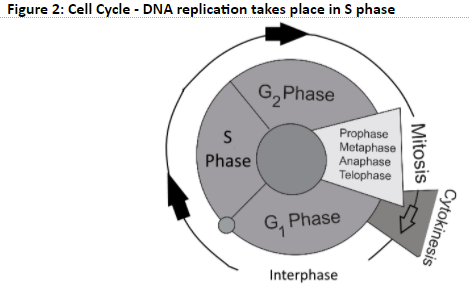
When a cell reproduces. What happens to its DNA, which is copied and passed into offspring?
Answer
583.8k+ views
Hint: Cell reproduces through a process known as cell cycle. Cell cycles have different stages like Growth phase, synthesis phase and mitosis. Changes in DNA take place during the synthesis phase and mitosis.
Complete answer:
One of the main steps during cell reproduction is DNA replication, where new DNA is synthesized from the copy of parent DNA. This DNA replication is known as semiconservative replication as the DNA formed is composed of one strand (50%) of parental DNA and a newly synthesized (50%) strand. During DNA replication DNA is first unwound by helicase enzyme, opening up the double-stranded DNA like a fork, separating the two strands. These strands then are used as a template strand to synthesis a new DNA strand complementary to the template/parental strand. The synthesis of a new strand occurs on both the parental strands separately in antiparallel directions. The newly synthesized strand and the template strands are joined together to form a new dsDNA (double-stranded DNA).

Cell reproduces through a process called the cell cycle. Cell cycle involves 4 stages: Gap 1 ($G_1$) where cell increases in size, duplicates cellular contents and prepare for next phase (S), Synthesis ($S_1$) phase is where DNA replication takes place through semiconservative replication, Gap 2 ($G_2$) phase is the preparation phase for cell division either through meiosis or mitosis and the cell grows in size, and the last stage is Mitosis phase (M) involving equal division of DNA followed by cytokinesis resulting in the formation of two identical daughter cells. These newly formed cells either undergo the cell cycle again or enter a resting state known as Gap 0 ($G_0$) phase. Cells enter the $G_0$ phase after existing from the $G_1$ phase. Cells in the $G_0$ phase perform all its function and undergo terminal differentiation, without actively preparing to divide.

Additional Information: The human body has two types of cells: Germ cells and Somatic cells. Germ cells divide and reproduce by a process called Meiosis and Somatic cells on the other hand divide and reproduce by a process called Mitosis.
Note: DNA carries hereditary information that acts as blueprints of the body design. This hereditary information is copied by semiconservative replication during the synthesis phase of a cell cycle. Interphase: is the stages in the cell cycle between one mitosis and the next, which include $G_1$, S, and $G_2$ phases.
Complete answer:
One of the main steps during cell reproduction is DNA replication, where new DNA is synthesized from the copy of parent DNA. This DNA replication is known as semiconservative replication as the DNA formed is composed of one strand (50%) of parental DNA and a newly synthesized (50%) strand. During DNA replication DNA is first unwound by helicase enzyme, opening up the double-stranded DNA like a fork, separating the two strands. These strands then are used as a template strand to synthesis a new DNA strand complementary to the template/parental strand. The synthesis of a new strand occurs on both the parental strands separately in antiparallel directions. The newly synthesized strand and the template strands are joined together to form a new dsDNA (double-stranded DNA).

Cell reproduces through a process called the cell cycle. Cell cycle involves 4 stages: Gap 1 ($G_1$) where cell increases in size, duplicates cellular contents and prepare for next phase (S), Synthesis ($S_1$) phase is where DNA replication takes place through semiconservative replication, Gap 2 ($G_2$) phase is the preparation phase for cell division either through meiosis or mitosis and the cell grows in size, and the last stage is Mitosis phase (M) involving equal division of DNA followed by cytokinesis resulting in the formation of two identical daughter cells. These newly formed cells either undergo the cell cycle again or enter a resting state known as Gap 0 ($G_0$) phase. Cells enter the $G_0$ phase after existing from the $G_1$ phase. Cells in the $G_0$ phase perform all its function and undergo terminal differentiation, without actively preparing to divide.

Additional Information: The human body has two types of cells: Germ cells and Somatic cells. Germ cells divide and reproduce by a process called Meiosis and Somatic cells on the other hand divide and reproduce by a process called Mitosis.
Note: DNA carries hereditary information that acts as blueprints of the body design. This hereditary information is copied by semiconservative replication during the synthesis phase of a cell cycle. Interphase: is the stages in the cell cycle between one mitosis and the next, which include $G_1$, S, and $G_2$ phases.
Recently Updated Pages
The number of solutions in x in 02pi for which sqrt class 12 maths CBSE

Write any two methods of preparation of phenol Give class 12 chemistry CBSE

Differentiate between action potential and resting class 12 biology CBSE

Two plane mirrors arranged at right angles to each class 12 physics CBSE

Which of the following molecules is are chiral A I class 12 chemistry CBSE

Name different types of neurons and give one function class 12 biology CBSE

Trending doubts
One Metric ton is equal to kg A 10000 B 1000 C 100 class 11 physics CBSE

What is 1s 2s 2p 3s 3p class 11 chemistry CBSE

Discuss the various forms of bacteria class 11 biology CBSE

State the laws of reflection of light

Explain zero factorial class 11 maths CBSE

An example of chemosynthetic bacteria is A E coli B class 11 biology CBSE




